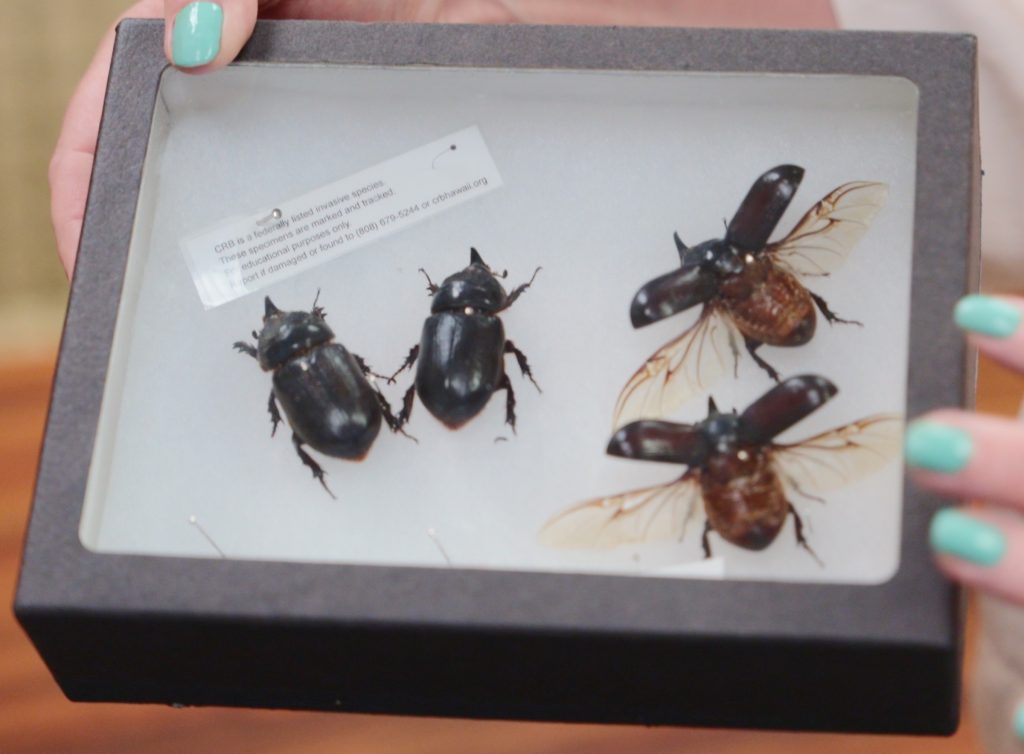Hawaiʻi County, in coordination with Hawaiʻi Department of Agriculture, is issuing a 3-month voluntary compliance order for parts of West Hawaiʻi — effective July 1 through Sept. 30 — to stop the movement of host materials for the invasive coconut rhinoceros beetle.
The order applies to where the invasive beetle has been detected during the past 6 months on Hawaiʻi Island, which is an area with borders including Waikōloa Road, Māmalahoa Highway (Highway 190) from Waikōloa Road to Palani Road in Kailua-Kona and along the West Hawaiʻi coastline from Palani Road to Waikōloa Road.
“The coconut rhinoceros beetle poses a serious threat to our island’s agriculture, and we are asking for your kōkua to stop the spread before it gets out of hand,” said Hawaiʻi County Mayor Kimo Alameda in the county’s announcement about the voluntary order. “Early intervention and cooperation are key to preventing long-term damage and protecting our island from this destructive invasive species.”
Residents and businesses in this area are asked not to transport materials that can host coconut rhinoceros beetles and their larvae in an effort to thwart the invasive insect’s spread.
Those materials include:
- Decomposing plant material such as compost, wood or tree chips and mulch.
- Plant propagation material.
- Other items — such as landscaping material — that are comprised of decomposing organic plant material.
- All live palm plants in the genera Cocos (coconut palm), Livistona (fountain palm or Chinese fan palm), Phoenix (date palm, Canary Island date palm), Pritchardia (loulu), Roystonea (royal palm) and Washingtonia (California fan palm, Mexican fan palm) — except unsprouted seeds of these palms.
ARTICLE CONTINUES BELOW ADARTICLE CONTINUES BELOW AD
Furthermore, anyone within the compliance area who needs to get rid of green waste should take the material to the following two proper disposal sites:
- West Hawaiʻi Organics Facility, located at 71-1111 Queen Ka’ahumanu Highway.
- Kealakehe Transfer Station, located at 74-598 Hale Makai Place.
Both facilities are located within the compliance area and heat compost piles to at least 131 degrees to kill coconut rhioceros beetle larvae.
Host materials, such as decomposing plant material, can contain the invasive beetle’s eggs, larvae and adults.
Moving such infested materials outside the compliance area could unintentionally spread the beetle far beyond its current range, complicating eradication efforts and hindering control measures.
 Coconut rhinoceros beetle larva. (Photo Courtesy: Hawaiʻi County)
Coconut rhinoceros beetle larva. (Photo Courtesy: Hawaiʻi County)
ARTICLE CONTINUES BELOW AD
Coconut rhinoceros beetle primarily targets coconut and other palm species. However, it will feed on other important crops such as ʻulu, banana and kalo when palm food sources are eliminated.
The voluntary compliance order is a precursor to a mandatory compliance structure being prepared by Hawaiʻi Department of Agriculture.
“Controlling the movement of green waste to stop the spread of [coconut rhinoceros beetle] is a call-to-action that all of us can do to protect Hawaiʻi Island,” said Hawaiʻi Board of Agriculture Chairperson Sharon Hurd in the county’s announcement.
BEST MANAGEMENT PRACTICES
Residents can take the following steps to minimize the risk of spreading coconut rhinoceros beetles:
ARTICLE CONTINUES BELOW AD
Inspect and report
- Inspect host materials at least every 4 months, especially finished compost and nearby host palms, for signs of the invasive insect or damage.
- Examine incoming host materials before accepting them to ensure they are not infested.
- Collect any suspected coconut rhinoceros beetles and report findings or visible damage from the invasive bugs to the state Agriculture Department at 808-643-PEST (7378) or Big Island Invasive Species Committee at 808-933-3340. Reports can also be made online.
- Contact Big Island Invasive Species Committee, CRB Response at 808-679-5244 or the state Department of Agriculture for assistance if you cannot inspect host materials yourself.
Properly manage materials
- Chip incoming host materials within 48 hours.
- Properly compost host materials by heating piles to at least 131 degrees.
- Monitor finished materials at least every 4 months (visual during turnover). Once compost cools to about 110 degrees, it can become infested and is a good breeding material for coconut rhinoceros beetles.
- Do not stockpile or keep a mound of host material. Routinely distribute around plants or thinly spread up to 4 inches in depth to enable it to dry completely.
Prevent the spread
- Use or process host materials that are already on-site for end use, eliminating the need to move potentially infested materials.
- Safeguard host materials that have been properly composted or treated in completely sealed containers that prevent coconut rhinoceros beetle entry. Containers made of metal, concrete or glass are acceptable. The invasive beetles can chew through many plastics.
- Ensure host materials are still at acceptable temperatures or subjected to effective treatment before being transported off site.
- Profume, a restricted-use pesticide, is one option for treating certain host materials such as compost. Call the state Agriculture Department for additional information about the use of this chemical.
- If you receive host materials, ensure they come from a reputable source that follows best management practices. Ask suppliers to provide documentation of their coconut rhinoceros beetle prevention efforts.
Contact Hawaiʻi County Economic Development Specialist Glenn Sako at 808-961-8811 with any questions or additional information about moving coconut rhinoceros beetle host materials.
 Adult coconut rhinoceros beetles. (Photo Courtesy: Hawaiʻi County)
Adult coconut rhinoceros beetles. (Photo Courtesy: Hawaiʻi County)

